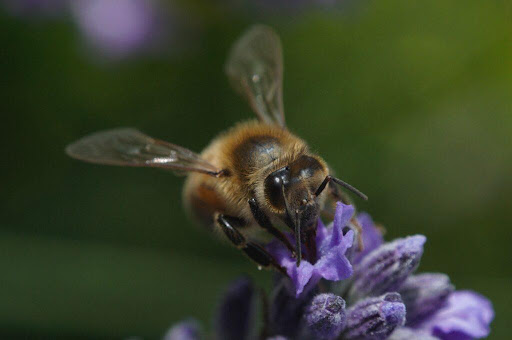Sitting round the table for lunch the conversation drifted to honey and all sorts of claims were made regarding its medicinal and magical properties. We had several vegans around the table and there were also discussions about the costs to bees and the environment of honey consumption; and the effect of large honey bee populations (native and non-native) on other bees, pollinators and parasites. Leaving aside these debates I decided to look a bit more closely at the evidence for honey as a foodstuff and remedy.

Nutritional value of honey?[1]
As a nutritionist this seems like a good place to start. Honey is mostly sugar. If we say an average serving is a tablespoon of honey this is around 20g. 20g of honey is 17g of sugar this is mostly fructose (40%) Glucose (35%) and Sucrose (9%) and some other simple carbs. Current recommendations on total daily added sugar intake for adults vary from 30g to 50g. Meaning one serving of honey is roughly one third to a half of total recommended intake.
Often when visiting sites on the web you will see long lists of vitamins and minerals found in honey. The vitamins and minerals in honey will vary depending on where and when the honey was produced but the fact remains the vitamin and mineral content never reaches a significant level in a normal serving.
Folate (or vitamin B9) one of the most abundant vitamins in honey. As on overall range honey generally contains 2 – 10 micrograms of folate per 100g. Let’s say on average we could hope to find 5 micrograms in a random sample. That is per 100g which is 5 servings of honey. The recommended daily adult intake of folate is 400 micrograms. Meaning if we wanted to get our daily allowance from honey we would need to consume 400 servings or 8kgs of honey. This is why generally the nutritional value of honey in terms of its vitamin and mineral content is seen as negligible.
From a nutritional perspective then honey is viewed similarly to added sugar and to be consumed sparingly if at all.
Antibacterial properties
Honey has been regularly used as a dressing for wounds, burns and ulcers due to its antibacterial properties. The antimicrobial properties of honey vary greatly depending on where the bees get their nectar from. Generally, all honeys have some antimicrobial activity but some can be 100 times more effective than others. High sugar and a low (acidic) pH help inhibit bacteria growth but these are not the only factors at play.
Bees incorporate an enzyme glucose oxidase into honey. When honey is applied topically to a wound it draws moisture from the tissue and this reacts with the glucose oxidase to form hydrogen peroxide clearing the wound of infection.
Some honeys also contain additional components that have an antibacterial effect. This is where Manuka Honey comes into the picture. Manuka honey is derived from the nectar from the Leptospermum scoparium trees (commonly known as tea tree). This honey has been shown to retain its antibacterial properties after the hydrogen peroxide has been removed. The chemical responsible for this is methylglyoxal and it is this that gives the Manuka honeys its UMF (or MGO) rating and is responsible for some of the astronomical prices being charged for it.
Given the hype you would be forgiven for thinking this gives Manuka honey the highest level of antimicrobial activity of any honey. According to this cross comparison of Australian honeys you would be wrong. Manuka in this study was comprehensively out performed by honey from Eucalyptus and Corymbia trees. All are good for wound dressings and applications to skin wounds, ulcers and burns. There are also no recorded cases of bacteria creating resistance to honey making it a valuable tool in the fight against superbugs.
And for sore throats?
There is also good evidence that honey is effective in alleviating the symptoms of upper respiratory tract infections and reduces cough frequency and severity. In fact, this meta-analysis published in the British Medical Journal concludes that it outperforms conventional treatments. They also recommend its use in place of pharmaceutical antibiotics as it does not exacerbate antimicrobial resistance.
So, what about hay fever?
I am sure we have all heard the theory that eating local honey introduces small doses of the local pollen and helps the body develop a tolerance / resistance. There is no scientific evidence for this. Whilst the theory is an interesting one that seems to appeal to our common sense it is not a logical one for a couple of reasons. The pollen that causes hay fever is dispersed by the wind but the pollen in honey is collected by the bee (with the plant using insects rather than wind to disperse pollen) so they are rarely if ever the same pollen. I was tempted at this point to say that inhaling something is very different from consuming it but as the only example I could think of was glue I thought it was best left out. That said if you try inhaling lemon juice or squirting it in your eye you will probably find the body reacts pretty badly. I haven’t tested it but I am fairly confident it won’t react any less strongly if you eat a slice of lemon drizzle cake first.
Other possible benefits:
The internet is awash with all sorts of claims for beneficial properties of honey. These range from curing cancer (for which there is yet to be any substantial evidence of an effect in humans) to reducing dental caries, and gingivitis (for which there is evidence from several randomised clinical trials with human subjects).
Many benefits are theorised from result of experiments in a petri dish in a lab or from experiments conducted on mice and rats. These are not a reliable predictor of what happens in humans as is demonstrated in this article.
Conclusion:
- Honey is an excellent topical treatment for wounds, ulcers and burns
- Honey (local or not) has no beneficial effects for hay fever
- Honey ideally chewed (in a honey ‘leather’) or in a lozenge can reduce gingivitis and dental caries
- Honey is an effective treatment for Upper Respiratory Tract Infections (URTIs)
- There is no real nutritional benefit to eating honey and it has a high sugar content
- If honey were used more by clinicians for wounds and URTIs it would help slow the development of superbugs
A final word on Manuka. Thanks to the marketing hype the majority of research being conducted on honey uses manuka. For that reason, many of the claims made about honey are made about Manuka. There is good evidence that demonstrates the beneficial properties of honey are not restricted to Manuka or that it is necessarily the best option. Writing this in the UK I can see no reason why anyone here should be paying a small fortune for honey flown from the furthest point away from them on the planet.
[1] Nutritional profile information is taken from US Department for Agriculture (as this is most commonly referenced in scientific publications).

